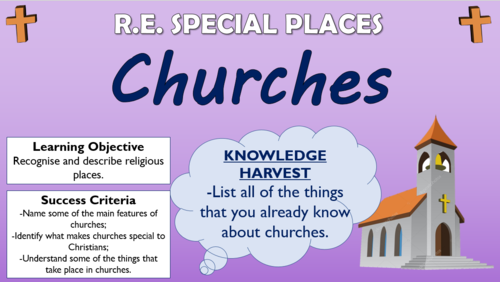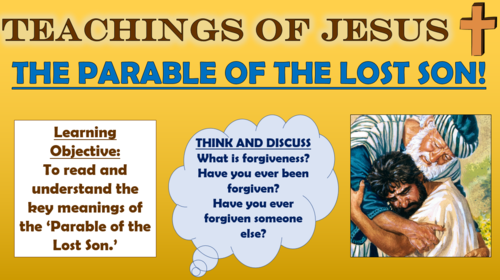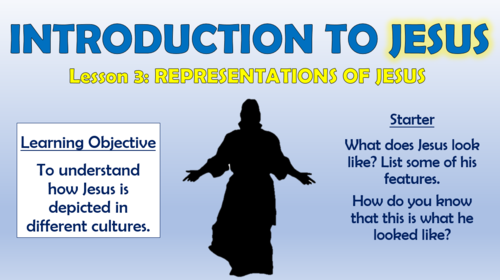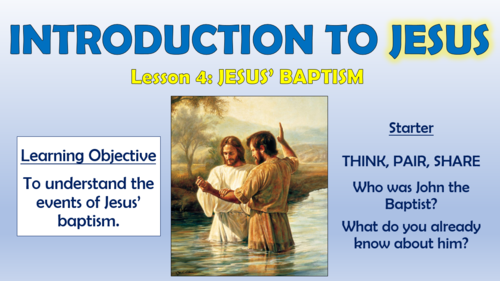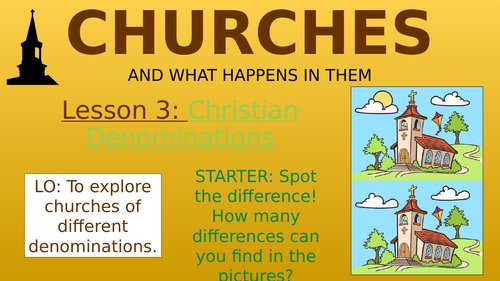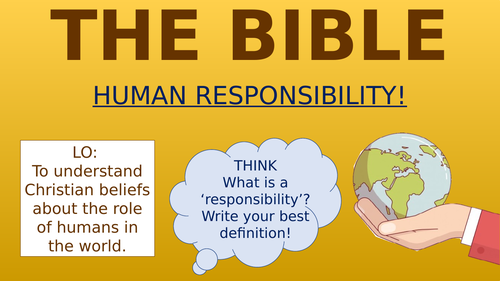
3k+Uploads
1889k+Views
2227k+Downloads
Religious education

Teachings of Jesus - Key Facts About Jesus Christ!
In this engaging lesson, students develop their understanding of Jesus Christ’s life and method of teaching.
The learning is guided by a clear and colourful PowerPoint presentation, which guides students through the following step-by-step journey:
-Knowledge harvesting - gauging what children already know about Jesus’s life and teachings;
-Researching to find out key facts about Jesus’ life;
-Discussing Jesus’ methods of teaching;
-Defining parables, and explaining how these differ from fables;
-Creating their own parables, following a clear formula;
-Completing a plenary activity to assess their understanding;
-Self-reflecting on the extent to which they feel they have met the learning objective.
In the past, I have used this lesson with children from across Key Stage 2 - the key learning is aligned with curriculum expectations for RE, and also the content prescribed by most diocese regions. All images are licensed for commercial use.

KS1 RE - The Guru Granth Sahib!
In this engaging and informative lesson, students gain a clear understanding of the Guru Granth Sahib. They learn about how the holy book is treated and used by Sikhs, and they also learn about how it relates to the teachings and songs of Guru Nanak.
The learning is guided by a clear and colourful PowerPoint presentation, which guides students through the following step-by-step journey:
-Reflecting on and recalling knowledge that they already built about special words and stories in their RE learning;
-Learn key facts about Guru Nanak;
-Read a story about Guru Nanak’s disappearance, his reappearance, and his special purpose, and answer comprehension questions;
-Learn about how the Guru Granth Sahib - including how it contains Guru Nanak’s songs, how it is housed by Sikhs, its role in baby-naming, and how Sikhs customarily show respect to the book;
-Consider their own personal spirituality, thoughts and ideas, in relation to the information that they have learnt;
-Compose their own songs about things that are special to them;
-Self-reflecting on the extent to which they feel they have met the learning objective.
This resource pack includes the comprehensive PowerPoint presentation (16 slides) and the story for reading (in both Word and PDF). There is everything that you need here to teach the lesson.
In the past, I have used this lesson with children from across Key Stage 1 - the key learning is aligned with curriculum expectations for RE, and also the content prescribed by most diocese regions. All images are licensed for commercial use.

KS1 RE - The Life of a Vicar!
In this engaging lesson, students develop their understanding of the roles of vicars. They consider their routines and actions, and how vicars live their daily lives. It is great as a standalone lesson, or as a part of a unit on ‘special ways of living.’
The learning is guided by a clear and colourful PowerPoint presentation, which guides students through the following step-by-step journey:
-Thinking about the definition of a vicar (and how this differs from the more general definition of a priest;
-Introducing children to the daily life of vicars, including discussing their many roles and responsibilities, through watching an interesting and age-appropriate video;
-Answering questions to check their understanding of the roles of vicars;
-Completing a storyboard (using a provided template) to show the daily routine of vicars;
-Learning about the different clothes worn by vicars, before drawing and labelling a vicar in uniform;
-Considering questions that they would ask to a vicar if they were given the opportunity (you could email these to your local vicar, or even better, invite them in for a Q and A session);
-Self-reflecting on the extent to which they feel they have met the learning objectives.
This resource pack includes the comprehensive PowerPoint presentation (15 slides) the template for the storyboard, and the hyperlink for the video explaining about the daily life of a vicar. There is everything that you need here to teach the lesson.
In the past, I have used this lesson with children from across Key Stage 1 - the key learning is aligned with curriculum expectations for RE, and also the content prescribed by most diocese regions. All images are licensed for commercial use.

KS1 RE - Special Places - Churches!
In this engaging lesson, students develop their understanding of churches and what happens in them. It was originally taught as a part of an RE unit on ‘Special Places.’
The learning is guided by a clear and colourful PowerPoint presentation, which guides students through the following step-by-step journey:
-Knowledge harvesting what children already know about churches, and what they would like to find out;
-Studying a number of images of different features in churches (provided) and using a template to record their findings;
-Discussing and identifying what events take place in churches, and how these are commemorated;
-Understanding that churches are special places to Christians, and that we should behave respectfully when we are in/ around them;
-Completing a plenary activity to assess their understanding;
-Self-reflecting on the extent to which they feel they have met the learning objective.
This resource pack includes the comprehensive PowerPoint presentation (23 slides) and the template & pictures for the main activity (provided in Word and PDF). There is everything that you need here to teach the lesson.
In the past, I have used this lesson with children from across Key Stage 1 - the key learning is aligned with curriculum expectations for RE, and also the content prescribed by most diocese regions. All images are licensed for commercial use.

Teachings of Jesus - The Parable of the Lost Son!
In this engaging lesson, students read and interpret ‘The Parable of the Lost Son’ (also known as the Parable of the Prodigal Son).
The learning is guided by a clear and colourful PowerPoint presentation, which guides students through the following step-by-step journey:
-Defining what ‘forgiveness’ means;
-Knowledge recall - remembering key facts about Jesus’ life and teaching;
-Understanding how it can be difficult, but important, to forgive;
-Watching an engaging, age-appropriate video of the parable;
-Demonstrating understanding of the parable through Bloom’s Taxonomy-style activities, including defining, remembering, inferring, sequencing, analysing, applying and creating activities;
-Considering the messages that they can take for their own lives from this parable;
-Self-reflecting on the extent to which they feel they have met the learning objective.
The resource pack includes everything you need to teach the lesson, including the comprehensive PowerPoint presentation and the Bloom’s Taxonomy worksheet (provided in both Word and as a PDF). Just download and teach!
In the past, I have used this lesson with children from across Key Stage 2 with minor adaptations for age - the key learning is aligned with curriculum expectations for RE, and also the content prescribed by most diocese regions. All images are licensed for commercial use.

The Bible - The Ten Commandments!
In this engaging and informative lesson, students learn about the different ways in which Christians interpret the Bible, with a particular focus on the Ten Commandments. They learn through:
-Recalling and remembering foundation contextual facts about the Bible;
-Predicting, reading, interpreting and sequencing the Ten Commandments;
-Analysing how different Christians may read the commandments, depending upon if they are fundamentalist or liberal;
-Considering important rules and procedures that should be followed at school, to create their own 'School Commandments’;
-Evaluating their School Commandments through thought-provoking reflection questions;
This resource pack contains a comprehensive and colourful 16-slide Powerpoint, which guides teachers and students through the learning activities. Challenge activities are provided in order to enrich learning for higher-attaining learners. A template worksheet is also provided (in Word and PDF) for the students to scribe their school commandments.
In the past, I have used this lesson with children from across Key Stage 2 - the key learning is aligned with national expectations for RE, and also the content prescribed by most diocese regions.
This lesson is suitable for remote learning.
All images are licensed for commercial use, and are cited on the final slide.

Introducing Jesus - Representations of Jesus!
In this engaging lesson, students develop their understanding of how Jesus Christ is visually depicted in paintings, focusing on facial expression, body language, his effect on his immediate environment, and other features. They also begin to look at how Jesus has been depicted over time and in different cultures.
The learning is guided by a clear and colourful PowerPoint presentation, which guides students through the following step-by-step journey:
-Personal Spirituality - considering how people (including themselves) can be represented;
-Understanding how no one today knows for sure how Jesus looked, and the paintings that we see of him are artists’ representations;
-Analysing how Jesus is represented in some famous paintings of different events in his life;
-Creating their own painting of Jesus from an event in his life, considering how Jesus himself is represented.
This resource pack contains a comprehensive Powerpoint, alongside an eye-catching, and helpful worksheet.
In the past, I have used this lesson with children from across Key Stage 2 - the key learning is aligned with curriculum expectations for RE, and also the content prescribed by most diocese regions. All images are licensed for commercial use.

Introducing Jesus - Jesus' Baptism!
In this engaging lesson, students are introduced to the events and significance of the baptism of Jesus Christ.
The learning is guided by a clear and colourful PowerPoint presentation, which guides students through the following step-by-step journey:
-Knowledge harvesting - gauging what children already know about John the Baptist;
-Learning about the life of John the Baptist;
-Watching a short video (hyperlinked) about the Baptism of Jesus Christ;
-Freeze Framing Activity - The main events of the Baptism;
-Considering deeper thinking questions on the significance of the Baptism;
-Personal Spirituality - Milestones and turning points in our own lives.
This resource pack contains a comprehensive Powerpoint, alongside a clear and detailed information sheet for the introductory activity.
In the past, I have used this lesson with children from across Key Stage 2 - the key learning is aligned with curriculum expectations for RE, and also the content prescribed by most diocese regions. All images are licensed for commercial use.

RE - Islam - Features of Mosques!
In this engaging and comprehensive lesson, students are introduced to the main features of mosques. They learn the names and purposes of a number of different features of mosques, including minarets, domes, prayer halls, and mihrabs.
Children learn through collating their collective prior knowledge, accessing an engaging interactive online resource (hyperlinked) where they can explore a mosque, and recording the key information. They conclude by comparing the features of mosques with what they know about churches.
The lesson is tried and tested, and is easy for teachers and students to follow. It contains a comprehensive 15-slide Powerpoint which offers a step-by-step guide throughout the lesson. Challenge activities are provided in order to enrich learning for higher-attaining learners.
In the past, I have used this lesson with children from across Key Stage 2 - the key learning is aligned with national expectations for RE, and also the content prescribed by most diocese regions. All images are licensed for commercial use, and are cited on the final slide.

Churches - Christian Denominations!
In this lesson, students learn about the a number of the main types of Christianity, including Protestant (Anglican), Roman Catholic and Orthodox denominations.
Children learn about why there are different kinds of Christianity, before exploring the features of each faith and the respective churches.
This resource pack contains a comprehensive 14-slide Powerpoint, alongside all of the resources needed. A creative extension activity is also provided in order to challenge higher ability learners.
In the past, I have used this lesson with children from across Key Stage 2 - the key learning is aligned with NC expectations for RE, and also the content prescribed by most diocese regions. All images are licensed for commercial use, and are cited on the final slide.
Note - children will need access to computers/ books in order to complete the research task.

Mary, Mother of Jesus - Collective Worship Session!
This fun and original collective worship session aims to guide children towards building their knowledge of Mary, mother of Jesus, through:
-Gathering what they already know about Mary;
-Learning about the annunciation of Mary, through reading an engaging and thought-provoking script;
-Answering comprehension questions based on the ideas and events of the annunciation;
-Considering Mary’s response and actions after learning that she would be the mother of Jesus;
-Studying examples of Mary’s devotion and love towards Jesus, through engagement with religious artworks and Bible quotations;
-Discussing the Christian values that Mary demonstrated throughout her life;
-Singing a hymn about the Mother Mary (hyperlinked);
-Closing with a prayer related to the Mother Mary.
The session includes a 16-slide presentation, the script for the ‘anunciation’ section (in both Word and PDF) and the hyperlink to the hymn. No further resources are required, everything that you need to present the assembly is included.
This assembly was originally delivered to all of the children in a primary school (KS1 and KS2), although with suitable adaptations it could also be suitable for students in KS3.

The Bible - Respect for the Bible!
In this engaging and informative lesson, students learn about the different ways in which the Bible influences our daily lives. They also learn how different Christian denominations look after the Bible. They learn through:
-Recalling and remembering foundation contextual facts about the Bible;
-Understanding how the Bible has affected different parts of our lives, including laws, the arts, celebrations and events, and our perception of meaning and purpose;
-Learning about how Anglican, Catholic and Orthodox Christians look after the Bible in their churches;
-Considering books that are important to them in their lives, thinking about how they look after them, and what they learn from them;
-Challenging themselves to consider a world without books, and the impact that this might have on society;
This resource pack contains a comprehensive and colourful 16-slide Powerpoint, which guides teachers and students through the learning activities. Challenge activities are provided in order to enrich learning for higher-attaining learners. A worksheet is also provided (in Word and PDF) for the students to consider they respect their favourite books.
In the past, I have used this lesson with children from across Key Stage 2 - the key learning is aligned with national expectations for RE, and also the content prescribed by most diocese regions.
The resource is also suitable for home learning
All images are licensed for commercial use, and are cited on the final slide.

The Bible - Human Responsibility!
In this engaging and informative lesson, students learn about how the Bible teaches of humans’ responsibility for looking after the Earth. They consider how humans are faring with this responsibility at present, before exploring ways that we can look after our planet going forwards. They learn through:
-Recalling and remembering foundation contextual facts about the Bible;
-Defining the term ‘responsibility’ and learning how God gave humans responsibility for looking after planet Earth (Creation Story - Genesis 1 and 2);
-Using research skills to explore given websites and find out how humans are treating the planet at present;
-Considering their own roles in fulfilling the human responsibility;
-Designing posters to enable other people to save our planet as a part of our human responsibility.
This resource pack contains a comprehensive and colourful 17-slide Powerpoint, which guides teachers and students through the learning activities. Challenge activities are provided in order to enrich learning for higher-attaining learners. An eye-catching and helpful research template (in both Word and PDF) is also included.
In the past, I have used this lesson with children from across Key Stage 2 - the key learning is aligned with national expectations for RE, and also the content prescribed by most diocese regions.
The resource is also suitable for home learning
All images are licensed for commercial use, and are cited on the final slide.

Introducing Jesus - Events in His Life!
In this engaging lesson, students develop their understanding of the key events in the life of Jesus Christ.
The learning is guided by a clear and colourful PowerPoint presentation, which guides students through the following step-by-step journey:
-Personal Spirituality - considering important events in their own life;
-Comprehending and sequencing - card-sorting the main events in Jesus’ life;
-Using independent research skills to find out more about one of the key events in Jesus’ life, before creating newspaper reports detailing their findings;
-Considering a deeper thinking question, with the aid of clear points for consideration;
-Completing a plenary quiz to assess their understanding.
This resource pack contains a comprehensive Powerpoint, alongside an eye-catching worksheet.
In the past, I have used this lesson with children from across Key Stage 2 - the key learning is aligned with curriculum expectations for RE, and also the content prescribed by most diocese regions. All images are licensed for commercial use.

Churches - Church Symbols!
In this lesson, students learn about the key symbols found across Christianity, and in particular in churches.
Some of the symbols covered include: the cross/crucifix, alpha/omega, the sign of the holy trinity, and the animal symbols of the disciples. Students learn about what symbols are used for, before discussing the key meanings of the church symbols.
This resource pack contains a comprehensive 15-slide Powerpoint, alongside all of the resources needed for the group ‘symbol detectives’ activity (for this task, I put the symbols and clues around the room, and have groups do a circuit of them. A creative extension activity is also provided in order to challenge higher ability learners.
In the past, I have used this lesson with children from across Key Stage 2 - the key learning is aligned with NC expectations for RE, and also the content prescribed by most diocese regions. All images are licensed for commercial use, and are cited on the final slide.

RE - Sikhism - The Ten Gurus!
In this engaging lesson, students develop their understanding of Sikhism through learning about the ten human gurus.
The learning is guided by a clear and colourful PowerPoint presentation, which guides students through the following step-by-step journey:
-Recalling key information about the life and beliefs of Guru Nanak;
-Researching the nine subsequent Sikh Gurus, using a structured template;
-Sharing their findings with their classmates;
-Considering the key messages communicated by each of the Sikh gurus and justifying which they feel are the most important;
-Completing a creative task in which they make a Sikh Guru timeline;
-Self-reflecting on the extent to which they feel they have met the learning objectives.
This resource pack includes the comprehensive PowerPoint presentation (17 slides) and the research template. There is everything that you need here to teach the lesson.
In the past, I have used this lesson with children from across Key Stage 2 - (predominantly upper KS2) the key learning is aligned with curriculum expectations for RE, and also the content prescribed by most diocese regions.

KS1 RE - Comparing Special Books!
In this engaging and informative lesson, students develop their understanding of the Bible, the Megillat Esther, and the Guru Granth Sahib, through comparing and contrasting the three texts. They learn and remember key facts about the texts, before discovering how to use connectives to write comparing and contrasting sentences.
The learning is guided by a clear and colourful PowerPoint presentation, which guides students through the following step-by-step journey:
-Playing an engaging game (embedded in slide show) to remember key facts about the Bible, the Megillat Esther and the Guru Granth Sahib);
-Learning more key facts about the three texts;
-Understanding how adding and contrasting connectives can be used to write comparative sentences;
-Applying this knowledge to write comparative sentences about the three religious texts;
-Peer assessing each others’ comparative sentences;
-Consider which books are special to them, and write about what makes them special;
-Self-reflecting on the extent to which they feel they have met the learning objective.
This resource pack includes the comprehensive PowerPoint presentation (20 slides) which has everything that you need to teach the lesson.
In the past, I have used this lesson with children from across Key Stage 1 - the key learning is aligned with curriculum expectations for RE, and also the content prescribed by most diocese regions. All images are licensed for commercial use.

Judaism - Moses and the Burning Bush - Lesson!
In this engaging lesson, students are introduced to the story of Moses and the Burning Bush. They are encouraged to think deeply about the meanings that can be taken from the story, and consider the main ‘turning points’ in their own lives and the lives of others.
The learning is guided by a clear and colourful PowerPoint presentation, which guides students through the following step-by-step journey:
-Knowledge recall - gauging children’s prior knowledge of Judaism - including Jewish persecution in Egypt and Moses’ early life;
-Reading the story of Moses and the Burning Bush - pausing for reflective thought by engaging with the embedded questions;
-Considering the deeper meanings and morals of the story - including Moses’ killing of the Egyptian and his worries about leading the Israelites;
-Considering their own attitudes towards the events and characters in the story;
-Comparing Moses’ turning point with turning points from other religions;
-Thinking of how turning points in their own lives have affected them;
-Completing a plenary to assess their understanding.
This resource pack contains a comprehensive 15-slide Powerpoint and the story/ consideration questions (in both Word and PDF).
In the past, I have used this lesson with children from across Key Stage 2 - the key learning is aligned with curriculum expectations for RE, and also the content prescribed by most diocese regions. All images are licensed for commercial use.

The Bible - Introduction to the Bible!
In this lesson, students learn about the key features of the Bible, including:
-What the Bible is comprised of;
-What the Bible tells Christians;
-Different versions of the Bible;
-Further information about the Old Testament and the New Testament;
-Different types of writing in the Bible.
Children learn through collating prior knowledge of about the Bible, watching an interesting video (hyperlinked) and recording the key information, and exploring Bibles for themselves (ensure that you have enough Bibles for each group to share one).
This resource pack contains a comprehensive 14-slide Powerpoint, alongside an eye-catching worksheet. Challenge activities are provided in order to enrich learning for higher-attaining learners.
In the past, I have used this lesson with children from across Key Stage 2 - the key learning is aligned with national expectations for RE, and also the content prescribed by most diocese regions. All images are licensed for commercial use, and are cited on the final slide.

The Bible - Bible Structure and Referencing!
In this engaging and informative lesson, students learn about the structure of the Bible, and gain an understanding of how to read and apply Bible references. They learn through:
-Recalling and remembering the different sections of the Bible;
-Considering what is detailed in each section;
-Understanding how and why Bible references are used;
-Applying knowledge of Bible references to a fun ‘Find the Animal’ game;
-Challenging their friends to find different details using references;
-Completing a ‘Bible Bookcase’ to remember the different sections of the Bible.
This resource pack contains a comprehensive and colourful 15-slide Powerpoint, alongside an eye-catching worksheet (2 different versions for different levels of learners in the class). Challenge activities are provided in order to enrich learning for higher-attaining learners.
A part of the lesson includes using Bibles, so you will need enough for at least one per group in your class.
In the past, I have used this lesson with children from across Key Stage 2 - the key learning is aligned with national expectations for RE, and also the content prescribed by most diocese regions. All images are licensed for commercial use, and are cited on the final slide.




